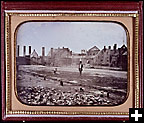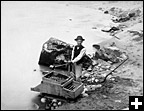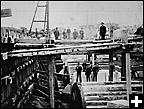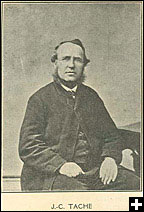Common menu bar links
Canadian statistics in 1879
Archived Content
Information identified as archived is provided for reference, research or recordkeeping purposes. It is not subject to the Government of Canada Web Standards and has not been altered or updated since it was archived. Please contact us to request a format other than those available.

By 1879, 12 editions of the Year Book and Almanac of Canada: Being an Annual Statistical Abstract of the Dominion and a Register of Legislation and of Public Men in British North America had been published, and they continued to be available from the printers. They were sold for $0.25 each or could be bought in volumes of four for $1.00 each. A person could buy all previous editions for only $3.25.
Several changes had been made since the 1867 edition. Editions now included a fold-out map of British North America and a record of public events of interest. Also, advertisements were strewn across its first pages. Readers could find out about a Singer Sewing Machine, said to be “The Best Family Machine in the World,” or learn about investing in the Hartford Fire Insurance Co., following the disastrous fires in Montréal and St. John.
Also, the publication process had changed. In 1871, Arthur Harvey, the editor of the book and the man responsible for reorganizing and publishing its first editions, passed the responsibility for publishing to the firm MacLean, Roger & Co., which would later be replaced by the Department of Agriculture.
Quoting demographic statistics from around the world
Information on the population of Canada was not available in the 1879 edition. Instead, it referred the reader to the Year Book and Almanac for 1875, where census data was provided.
The 1879 edition was the first to document the populations of foreign countries and the world. In 1878, the population of the entire world was believed to be 1.4 billion people, of which ‘America’ made up only 6%. The most populous country in the world was ‘China Proper,’ with 405.0 million people, followed by ‘British India’ with 188.4 million. Canada’s founding nations, France and Great Britain, boasted populations of 36.9 million and 34.2 million, respectively.
Surveying the interior

The Geological Survey of British Columbia in 1876/1877 was lead by G.M. Dawson, who scouted “the neighbourhood of Leech River, Vancouver Island.” The 1879 edition says, “Gold has been found in paying quantities for about five miles on this river. Some rich parts, Mr. Dawson thinks, yet exist in its neighbourhood, but limited in extent and difficult to find….The total product so far obtained has been estimated at $100,000.”
In October, 1876, the North-West Territories was created. It had a separate government, an appointed council and orders “to provide for the protection of the Buffalo, to prevent prairie and forest fires, [and] to prevent gambling, respecting infectious diseases, and respecting masters and servants.” Also in October of the same year, the District of Keewatin was detached from the territories and a council of six set up a Board of Health to counter the local smallpox epidemic.
Travelling by steamships, canals and railways

Under the Marine Department, the Dominion controlled five screw steamers, two paddle-wheel and two small steam launches in and around Canadian waters: Napoleon III, Druid, Lady Head, Newfield, Sir James Douglas, Richelieu, Northern Light, Dolphin and Alice.The last two—the steam launches—were “employed by the River Police at Quebec in preserving order among the shipping.”
The total expenditure on steamers aside from Lady Head, which was employed by the Fisheries Branch, was $182,947. These, ocean steamers belonging to the Allan Line of Steamers gave passage to 7,535 people from April 18 to November 23, 1878.
The Lachine Canal underwent rapid changes in which entrances to the canal were added to build a channel between the harbours of Montréal and Point St. Charles. The work was interrupted on December 17, 1877, by a workmen’s strike, which continued until Christmas Day.
By June 30, 1877, 5,574 miles of railway track were already operated by the Dominion, who had spent $82 million on the railways by this time. With Sir John A. Macdonald’s return to power in 1878, a contract with the Canadian Pacific Railway was signed to complete the intercontinental track.
Policing the populace
In the Dominion in 1877, the North-West Mounted Police consisted of 329 officers and 315 horses—a little shy of a fully mounted force. As for after the criminals were caught, they were placed in one of Canada’s five penitentiaries. The penitentiaries held over one thousand convicts.
Also, to help protect the country Canada had an active militia with almost 44,000 members.
Passing the Census and Statistics Act of 1879

In the same year, the Census and Statistics Act of 1879 further empowered the Department of Agriculture “to regulate the collection and publication of general statistics,” which included an official mandate to publish an annual statistical yearbook.
Joseph Charles Taché, the deputy head of what was then called the Board of Registration and Statistics, even with the Department of Agriculture behind him, was in no position to undertake this task while facing preparations for the upcoming 1881 Census of Canada. Since the editions had maintained a commercial, quasi-official status since the beginning, overhauling the contents to fulfill the requirements of the new act would be too large an undertaking. As a result, the publication was disbanded and retired until it was revived again in the mid-1880s.
